Related Research Articles
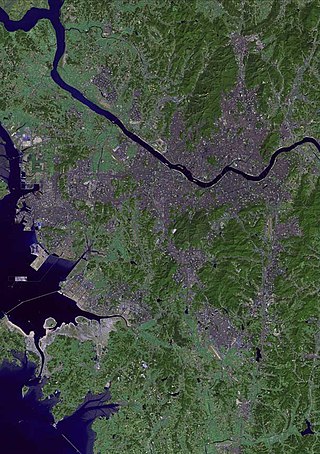
The Han River is a river in the central region of the Korean peninsula, with some of its tributaries and drainage basin in North Korea. It is classified as a national first-class river in South Korea. The Han River currently has eight river islands: Nanjido, Yeouido, Ttukseom, Nodeulseom, Seoraeseom, Sebitseom, Bamseom, and Seonyudo.
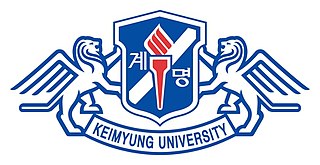
Keimyung University, abbreviated as KMU or Keimyung (Korean: 啓明), is a private university located in Daegu, the fourth largest city in South Korea. The university was founded in 1954 with the support of the leaders of the Northern Presbyterian Church of the U.S. as a Christian university. KMU is composed of three campuses in the city of Daegu, South Korea. They are named for their locations within the city; Daemyeong, which is near the downtown area, Seongseo, which is in the western part of the city, and also Dongsan campus which includes Dongsan Medical Center.
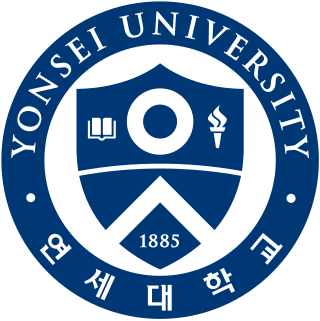
Yonsei University is a private Christian research university located in Seoul, South Korea. Yonsei is one of the prestigious group of three universities in the nation referred to as SKY universities.
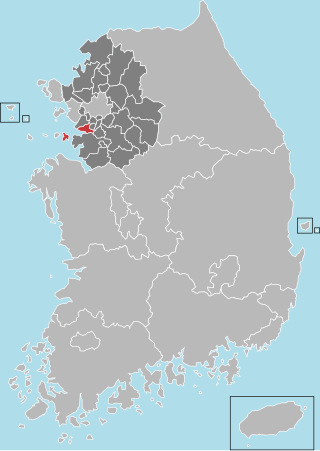
Ansan is a city in Gyeonggi Province, South Korea. It lies southwest of Seoul and is part of the Seoul National Capital Area. It is connected to Seoul by rail via Seoul Subway Line 4. It is situated on the Yellow Sea coast and some islands lie within its jurisdiction. The largest and best-known of these is Daebu Island.

Arena was a British monthly men's magazine. The magazine was created in 1986 by Nick Logan, who had founded The Face in 1980, to focus on trends in fashion and entertainment. British graphic designer Neville Brody, who had designed The Face, designed Arena's launch appearance.
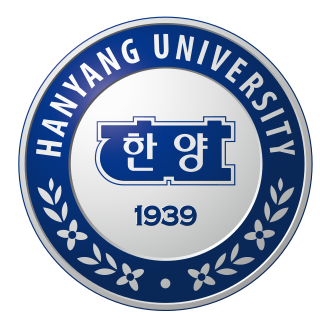
Hanyang University is a private research university in Seoul and Ansan, South Korea. Hanyang derives from the former name of the capital Seoul used during the Joseon period. The university was founded in 1939 as an engineering school, and was the country's first college to offer engineering and architecture programs.

Itaewon is a multi-cultural commercial area located in Seoul, South Korea. It is one of the most popular neighborhoods in Seoul, known for its nightlife and trendy restaurants.

Pak Mog-wol was an influential Korean poet and academic.

The Mehr News Agency is a semi-official news agency of the government of Iran. It is headquartered in Tehran, and is owned by the Iranian government's Islamic Development Organization (IIDO).
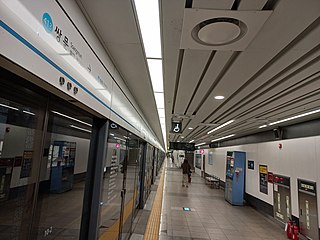
Ssangmun Station is an underground station on Seoul Subway Line 4 in Dobong-gu, Seoul, South Korea.
The Korea Herald is a South Korean English-language daily newspaper founded in August 1953 and published in Seoul, South Korea. The editorial staff is composed of Korean and international writers and editors, with additional news coverage drawn from international news agencies such as the Associated Press.

Konkuk University is a South Korean private university founded in 1931 and it is one of the top universities in South Korea. The university was founded based on three virtues: sincerity, fidelity, and righteousness.

Wangsimni Station is a station on Seoul Subway Line 2, Seoul Subway Line 5, Gyeongui–Jungang Line, and Suin–Bundang Line; most Suin–Bundang Line trains end service here, though a few daily services continue along the tracks used by the Gyeonggi-Jungang line to terminate at the next station, Cheongnyangni in northeastern Seoul. It is located in Haengdang-dong, Seongdong-gu, Seoul.

Dongdaemun History & Culture Park station (Korean: 동대문역사문화공원) is a station on Line 2, Line 4 and Line 5 of the Seoul Metropolitan Subway. It is named for the nearby Dongdaemun History & Culture Park. The huge Dongdaemun Market district is centered on this station and Dongdaemun Station, located to the north across Cheonggyecheon.

Seoul, the capital of South Korea, has been called by a number of formal and informal names over time. The word seoul was originally a common noun that simply meant "capital city", and was used colloquially to refer to the capital throughout Korean history. Seoul became the official name of the South Korean capital after its liberation from Japan after the Second World War.
Traditionally, Korean legal education followed the German and Japanese models. Recent reforms are shifting professional education from an undergraduate LL.B. to a postgraduate J.D. type of education. In addition, many Korean universities continue to offer legal education in academic and scholastic frameworks, offering graduate degrees, including Ph.D.s in Law. Further, several universities focus on legal systems outside of Korea, such as on Common Law.
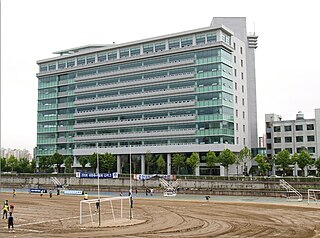
Fusion Technology Center is a building for research on "fusion technologies" in South Korea. It was constructed under the sponsorship of the city of Seoul and Hanyang University. The headquarters of Asian Research Network is in this center. In January 2009, Taro Aso, the former Prime Minister of Japan visited this building to encourage researchers.
Founded in October 2008, 10 Magazine is an English language, "events-led" monthly magazine published in Seoul, South Korea. The content focuses on the month's events around the country and entertaining activities to experience while visiting or residing in Korea.

Kim Seong-Kon, also known as Seong-Kon Kim, is a South Korean academic, literary critic, film critic, columnist, editor and writer. Currently, Kim is a professor emeritus at Seoul National University.

David Alan Mason is an American academic usually based in South Korea. He has been a professor of cultural tourism at Sejong University in Seoul since 2014. He has authored about 10 prominent books on Korean culture, spirituality, travel and mountains, and serves as a scholar, author, public speaker and tour guide. He remains a well-known authority on Korean spiritual traditions of all kinds, especially about his core topic the Sansin deity and their shrines found throughout Korea called Sansin-gak, integral parts of Korean Buddhist temples, Korean Shamanism and village life. He is also an expert on the Baekdu-daegan mountain range and Korea's national parks, having visited all 20 as of 2011.
References
- ↑ "한국어 가르치는 외국인 강사 스티븐 리비어(사범대·영어교육) 전임강사". 뉴스H (in Korean). 2005-02-08. Retrieved 2023-09-19.
- ↑ Survival Korean
- 1 2 Shin, Woo-seung (February 2002). An Interview with Stephen Revere of ‘Survival Korean’. Weekly Hanyang. Accessed March 31st, 2010.
- ↑ 10 Magazine. Stephen Revere Archived 2010-03-16 at the Wayback Machine . Accessed March 31st, 2010.
- ↑ Asia Latin Culture Festival Archived 2010-02-25 at the Wayback Machine . Accessed March 31st, 2010.
- ↑ Kim, Tari (March 1st, 2010). “Media Men Got Lost in Translation.” JoongAng Daily. Accessed March 31st, 2010.
- 1 2 Zwetsloot, Jacco (February 11th, 2009). “New English Magazine Aims for 10 Out of 10.” Korea.net: Gateway to Korea. Accessed March 31st, 2010.
- ↑ About 10 Magazine Accessed March 31st, 2010.